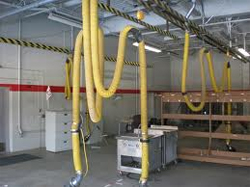
Categories
- Home
- Automotive Exhaust Ventilation
- Exhaust Fan Ventilation
- Exhaust Ventilation Fan
- Exhaust Ventilation Fans
- Exhaust Ventilation FAQs
- Exhaust Ventilation Hose
- Exhaust Ventilation System
- Garage Exhaust Ventilation
- Garage Exhaust Ventilation System
- General Exhaust Ventilation
- Local Exhaust Ventilation Definition
- Local Exhaust Ventilation Design
- Local Exhaust Ventilation Suppliers
- Local Exhaust Ventilation Systems
- Local Exhaust Ventilation Testing
- Mechanical Exhaust Ventilation Systems
- Portable Local Exhaust Ventilation
- Shop Exhaust Ventilation System
- Vehicle Exhaust Ventilation System
- Ventilation Exhaust Fan
- Ventilation Exhaust Fans
- Ventilation Exhaust Systems
- Welding Exhaust Ventilation
Local Exhaust Ventilation Systems
If there is one single method that can help you deal with airborne contaminants and strong smells with equal ease, it would have to be an exhaust ventilation system. With the help of local exhaust ventilation systems, you will be able to make your workplace a lot more pleasant and more productive, not to mention reduce the risk of health issues considerably.
Requirements for using local exhaust ventilation
There are certain design principles that guide the use of local exhaust ventilation systems. In conjunction with the installation of local exhaust ventilation systems, you will also have to ensure compliance with the following conditions in order to ensure the effectiveness of such systems:- You will have to eliminate air current in the immediate vicinity
- You will have to ensure minimal airflow resistance
- You will have to use an enclosed hood
Elimination of air currents with a ventilation system
Local exhaust ventilation systems are only as effective as their ability to draw in and expel air. Therefore, you will first have to make sure that there are no air currents around the workplace before local exhaust ventilation systems are installed. Pay particularly close attention to drafts that come from windows, doors, fans, and heating system and even people. If they are powerful enough, these drafts may severely impair the ability of local exhaust ventilation systems to clear out pollutants, odors, and hot air.Reducing resistance with a ventilation system
You will also have to make sure that airflow resistance is kept at an absolute minimum. This can be accomplished by ensuring good airflow design in specific components of local exhaust ventilation systems. It is important to note that the air that is drawn into the hoods of such systems typically encounter a lot of resistance. This resistance is commonly referred to as "static pressure".What is the implication of this pressure with regard to the effectiveness of local exhaust ventilation systems? As air enters the hood, its molecules are pressed tightly together, and it is coursed through the hood at a much faster rate than normal. If the airflow is hindered to a considerable degree, the ability of local exhaust ventilation systems to expel unwanted air may be affected adversely.
Enclose the hood of the ventilation system
Finally, you will have to make sure that the hoods used in local exhaust ventilation systems are as enclosed as possible. Depending on your particular application, you may get better results with local exhaust ventilation systems that feature a booth rather than the commonly employed "slot hood". You may also opt for designs that utilize side curtains and flanges in order to improve their efficiency even more.Back to Top
